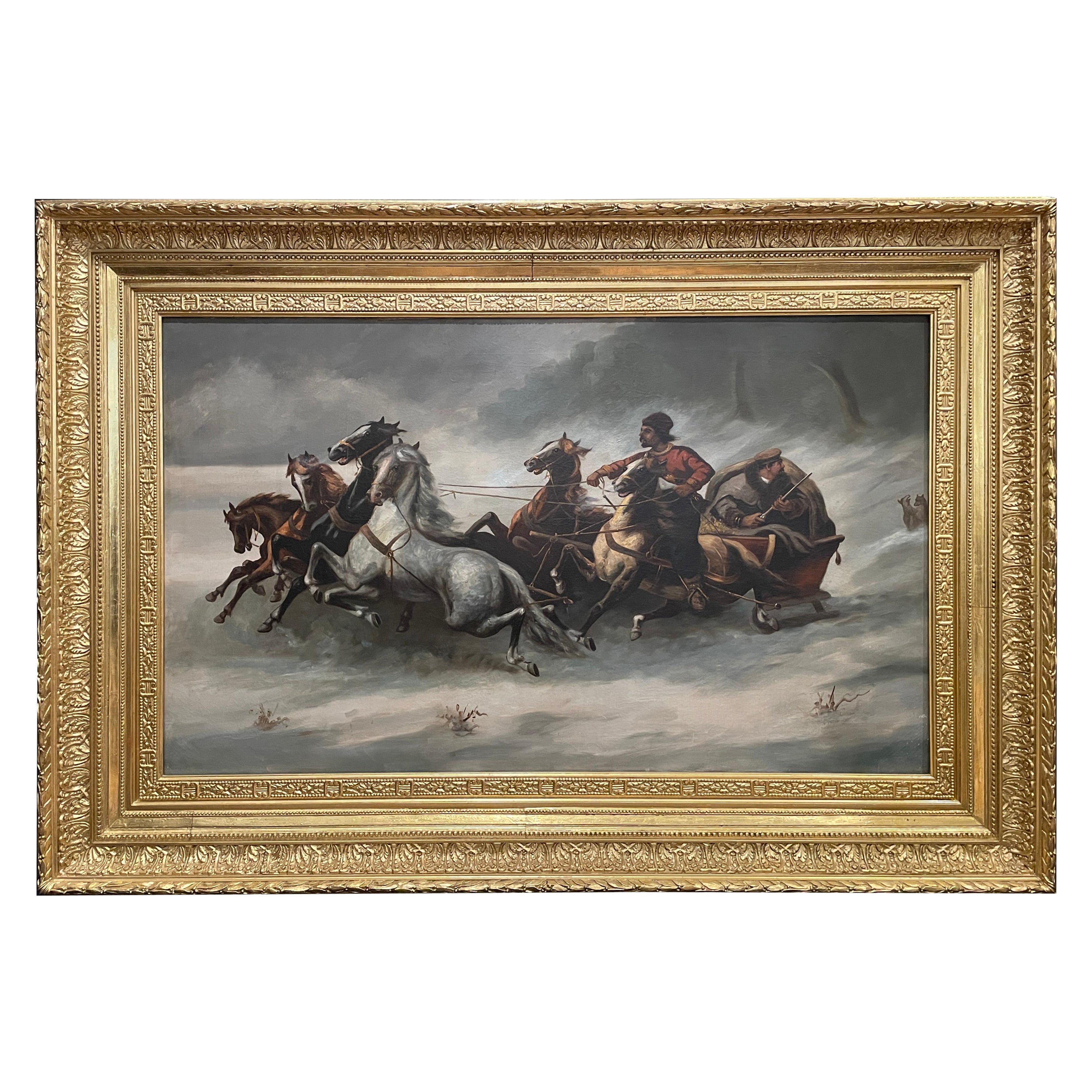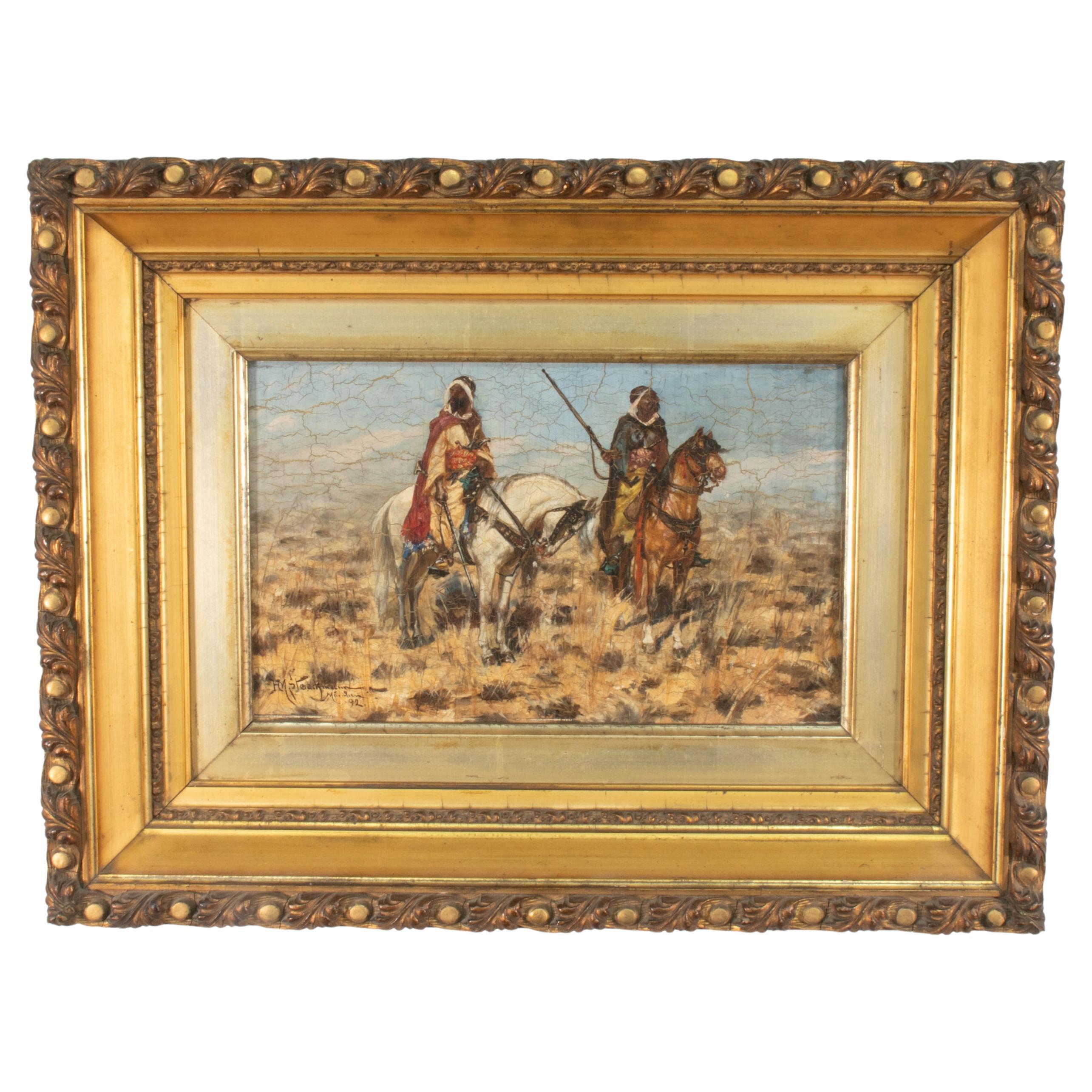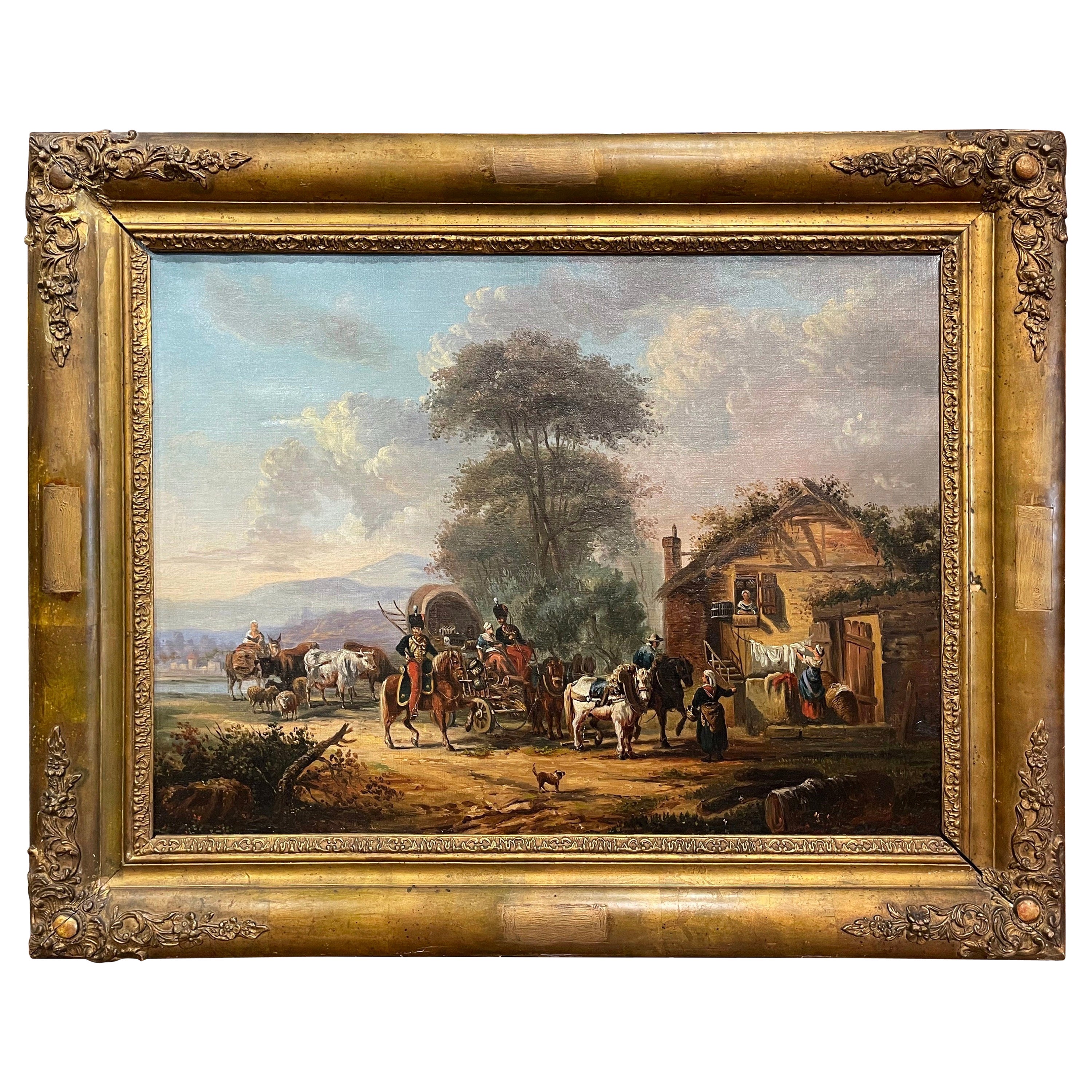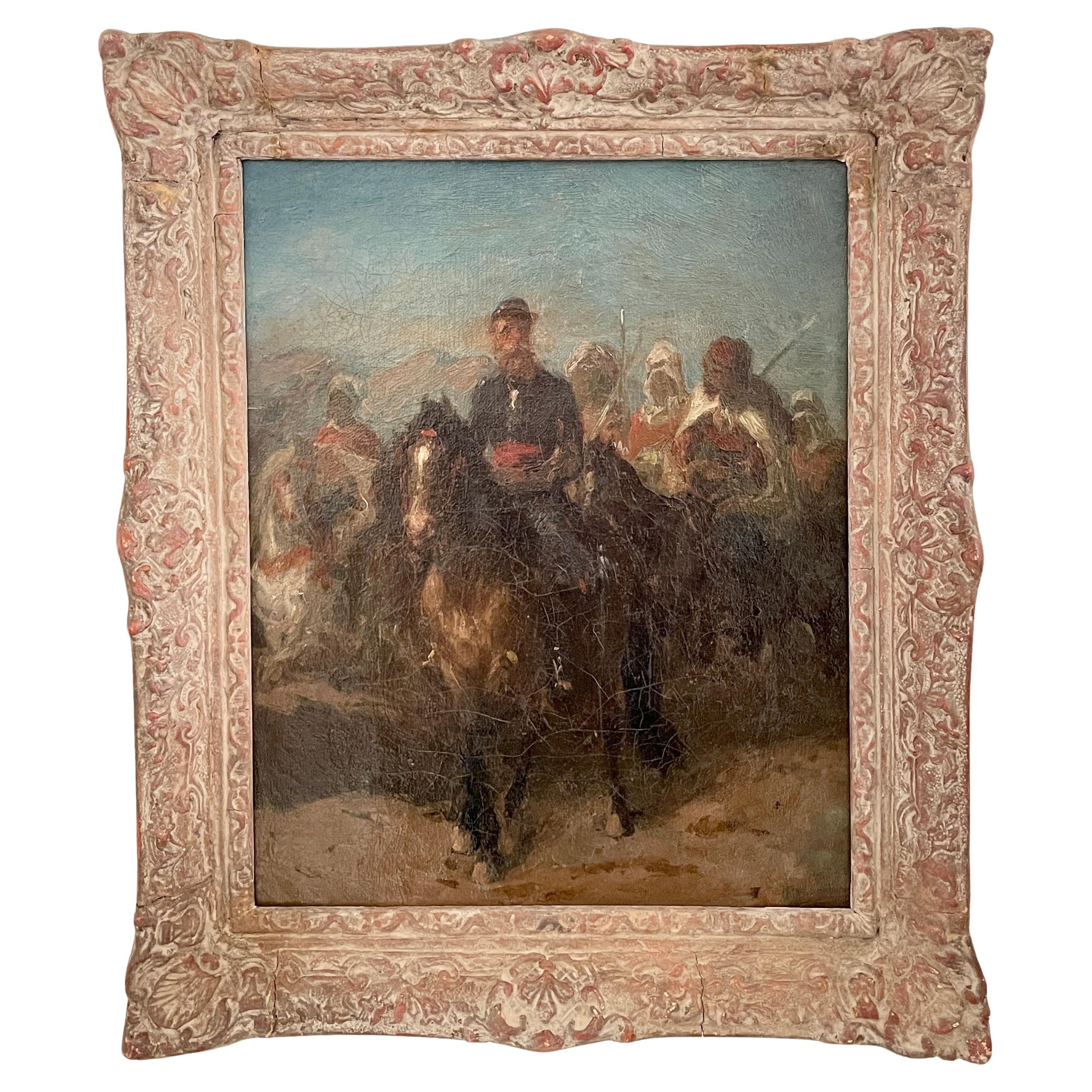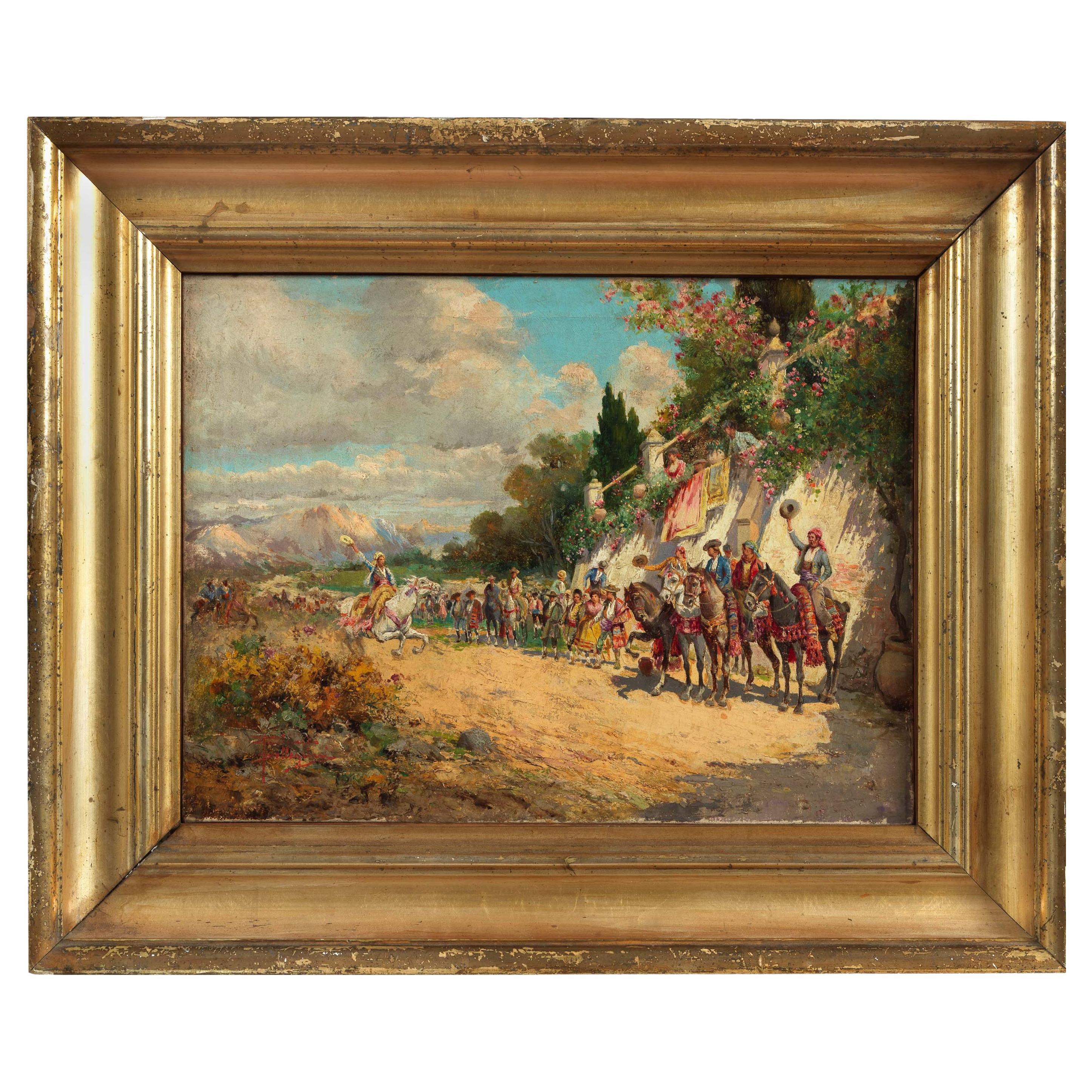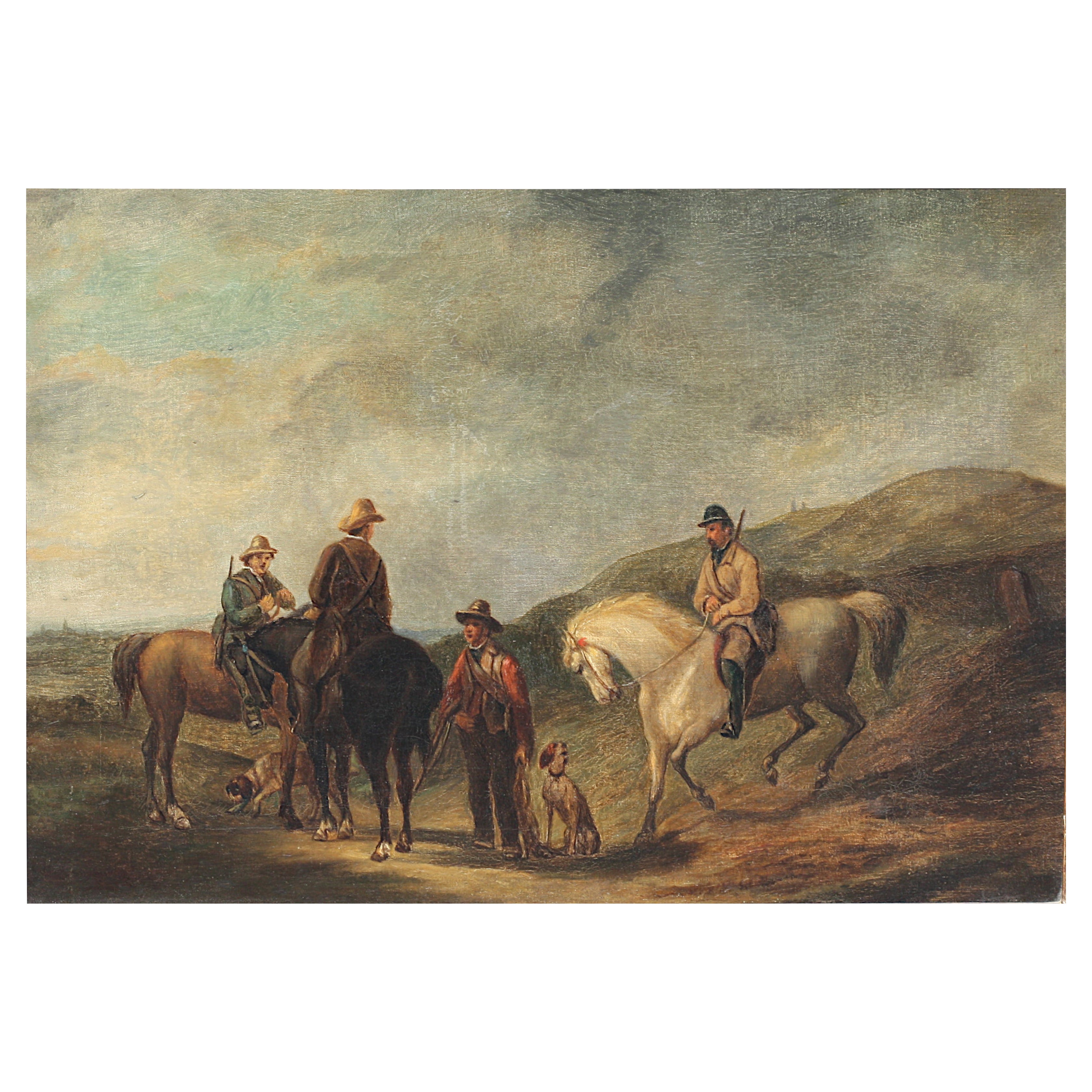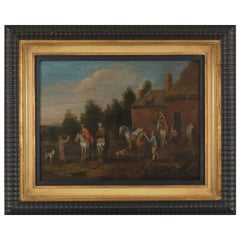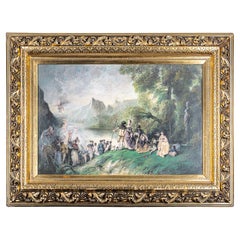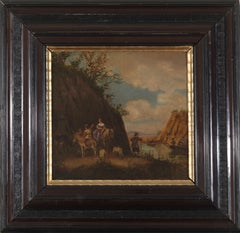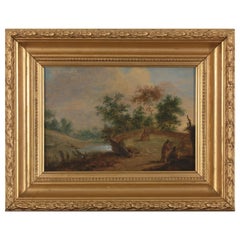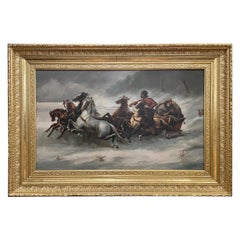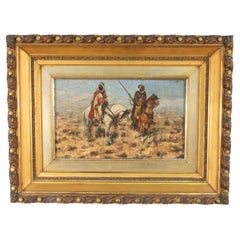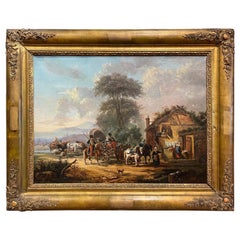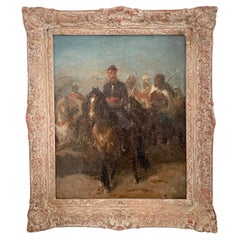Items Similar to Allegorical Scene of the Lewis and Clark Expedition (1804–1806) Attr. to L.Cogni
Want more images or videos?
Request additional images or videos from the seller
1 of 5
Allegorical Scene of the Lewis and Clark Expedition (1804–1806) Attr. to L.Cogni
$41,715.45
£30,890.04
€35,000
CA$57,365
A$63,804.62
CHF 33,393.97
MX$778,205.92
NOK 419,607.38
SEK 394,694.92
DKK 266,465.79
About the Item
Allegorical Scene of the Lewis and Clark Expedition (1804–1806)
Attributed to Léon Cogniet (1794–1880)
This ambitious and romanticized composition captures a defining moment in American history: the Lewis and Clark Expedition, commissioned by President Thomas Jefferson to chart a route to the Pacific Ocean through the newly acquired western territories. The painting centers on meticulously rendered figures—Lewis, Clark, Seaman (?), Charbonneau, Sacajawea, and her brother—each embodying the mythos surrounding the legendary journey.
A student of Pierre-Narcisse Guérin, like Delacroix and Géricault, Léon Cogniet worked during a stylistic transition, moving away from strict Neoclassicism while still retaining elements of it. His early work, Briséis Weeping over Patroclus, though unsuccessful in securing the Prix de Rome in 1815, reveals his classical roots and emerging coloristic sensibility. During his stay in Rome (1817–1822), he painted Castor and Pollux Rescuing Helen, a competition piece with a somber, mannerist tone influenced by Guérin.
Upon returning to France, Cogniet gained recognition, particularly at the Salon of 1824 with Scene of the Massacre of the Innocents, which marked a departure from the idealized narratives of Neoclassicism. Though he received official commissions and honors such as the Légion d'Honneur, he remained a discreet contributor to major public projects like the Musée de Versailles.
Highly praised by Baudelaire in 1845, Cogniet's portraits were favored over his historical vignettes. His works are held in various collections, including the Musée des Beaux-Arts d’Orléans. He also created a number of inventive landscape studies, showcasing his versatility and imaginative approach.
Provenance:
Marc Arthur Kohn Auctions, Hôtel Le Bristol, Paris, July 2, 2013
Cornelius Engelen, Leuven, Belgium
Private Collection, Belgium
For more detailed information on the Lewis and Clark Expedition, see:
Scène allégorique de l’expédition de Lewis et Clark (1804–1806)
Attribuée à Léon Cogniet (1794–1880)
Cette composition ambitieuse et idéalisée illustre un moment fondateur de l’histoire américaine : l’expédition de Lewis et Clark, commandée par le président Thomas Jefferson afin d’explorer les territoires de l’Ouest jusqu’à l’océan Pacifique. Le peintre met en scène des figures centrales soigneusement détaillées — Lewis, Clark, Charbonneau, Sacajawea et son frère — chacun incarnant un aspect du mythe entourant cette expédition légendaire.
Élève de Pierre-Narcisse Guérin, tout comme Delacroix et Géricault, Léon Cogniet évolue dans une période de transition stylistique, s’éloignant du néo-classicisme tout en en conservant certains éléments. Son œuvre Briséis pleurant Patrocle, qui ne lui vaut pas le Prix de Rome en 1815, témoigne encore de conventions classiques, bien que l’on y perçoive une sensibilité coloriste naissante. Lors de son séjour à Rome (1817–1822), il peint Castor et Pollux délivrant Hélène, un tableau de concours à l’atmosphère funèbre et maniériste, sous l’influence de Guérin.
De retour en France, Cogniet connaît le succès, notamment au Salon de 1824 avec sa Scène du massacre des Innocents, qui marque un rejet des canons idéalistes du néo-classicisme. Bien qu’il reçoive des commandes officielles et soit décoré de la Légion d’Honneur, il reste un contributeur discret aux grands chantiers publics tels que le Musée de Versailles.
Baudelaire loue particulièrement ses portraits, qu’il préfère à ses scènes historiques. Plusieurs de ses œuvres sont conservées au Musée des Beaux-Arts d’Orléans. Cogniet s’est également distingué par la fraîcheur et l’inventivité de ses nombreuses études de paysages.
Provenance :
Vente aux enchères Marc Arthur Kohn, Hôtel Le Bristol, Paris, 2 juillet 2013
Cornelius Engelen, Louvain, Belgique
Collection privée, Belgique
Pour une description plus complète de l’expédition de Lewis et Clark, voir :
Allegorische scène van de expeditie van Lewis en Clark (1804–1806)
Toegeschreven aan Léon Cogniet (1794–1880)
Deze ambitieuze en geromantiseerde compositie verbeeldt een bepalend moment in de Amerikaanse geschiedenis: de expeditie van Lewis en Clark, in opdracht van president Thomas Jefferson om de westelijke gebieden van het continent tot aan de Grote Oceaan te verkennen. De schilder brengt centraal in beeld gedetailleerde figuren — Lewis, Clark, Charbonneau, Sacajawea en haar broer — die elk een aspect van de mythe rond deze legendarische reis vertegenwoordigen.
Léon Cogniet, leerling van Pierre-Narcisse Guérin, net als Delacroix en Géricault, werkte in een periode van stilistische overgang waarin hij zich geleidelijk verwijderde van het neoclassicisme, zonder het volledig los te laten. Zijn werk Briséis treurend om Patroclus, dat hem in 1815 de Prix de Rome niet opleverde, toont nog klassieke conventies, hoewel er al een gevoel voor kleurgebruik zichtbaar is. Tijdens zijn verblijf in Rome (1817–1822) schilderde hij Castor en Pollux bevrijden Helena, een wedstrijdstuk met een sombere, maniëristische sfeer, beïnvloed door Guérin.
Na zijn terugkeer in Frankrijk kreeg Cogniet erkenning, vooral op de Salon van 1824 met Scène van de kindermoord, waarin hij afstand neemt van de idealistische en totaliserende benadering van het neoclassicisme. Hoewel hij officiële opdrachten en de Légion d’Honneur ontving, bleef zijn rol in grote staatsprojecten zoals het Musée de Versailles bescheiden.
Baudelaire prees vooral zijn portretten, die hij verkoos boven Cogniets historische scènes. Verschillende van zijn werken bevinden zich in het Musée des Beaux-Arts in Orléans. Cogniet onderscheidde zich ook met zijn levendige en inventieve landschapstudies.
Herkomst:
Veiling Marc Arthur Kohn, Hôtel Le Bristol, Parijs, 2 juli 2013
Cornelius Engelen, Leuven, België
Particuliere collectie, België
Voor een meer gedetailleerde beschrijving van de expeditie van Lewis en Clark, zie:
Allegorische Szene der Lewis-und-Clark-Expedition (1804–1806)
Zugeschrieben Léon Cogniet (1794–1880)
Diese ambitionierte und romantisierte Komposition zeigt ein zentrales Kapitel der amerikanischen Geschichte: die Lewis-und-Clark-Expedition, die von Präsident Thomas Jefferson in Auftrag gegeben wurde, um die westlichen Gebiete des nordamerikanischen Kontinents bis zum Pazifischen Ozean zu erkunden. Im Mittelpunkt des Bildes stehen sorgfältig ausgearbeitete Figuren – Lewis, Clark, Charbonneau, Sacajawea und ihr Bruder – die jeweils symbolisch für den Mythos dieser legendären Reise stehen.
Léon Cogniet, ein Schüler von Pierre-Narcisse Guérin – ebenso wie Delacroix und Géricault – wirkte in einer Zeit des stilistischen Umbruchs. Er entfernte sich allmählich vom strengen Klassizismus, ohne ihn ganz aufzugeben. Sein Werk Briseis beweint Patroklos, das ihm 1815 nicht den Prix de Rome einbrachte, zeigt noch klassische Konventionen, lässt jedoch bereits ein Gespür für koloristische Effekte erkennen. Während seines Romaufenthalts (1817–1822) schuf er das Gemälde Castor und Pollux befreien Helena, ein Wettbewerbsbild mit düsterer, manieristischer Atmosphäre, beeinflusst von Guérin.
Nach seiner Rückkehr nach Frankreich wurde Cogniet vor allem auf dem Salon von 1824 bekannt, wo er Szene des Kindermords ausstellte – ein Werk, das sich deutlich von der idealisierten neoklassizistischen Gesamtdarstellung distanziert. Er erhielt offizielle Aufträge und wurde mit der Ehrenlegion ausgezeichnet, spielte jedoch nur eine zurückhaltende Rolle bei großen Staatsprojekten wie dem Musée de Versailles.
Baudelaire lobte besonders Cogniets Porträts, denen er den Vorzug vor seinen historischen „Vignetten“ gab. Mehrere seiner Werke befinden sich heute im Musée des Beaux-Arts in Orléans. Cogniet widmete sich zudem einer Vielzahl von Landschaftsstudien, die durch besondere Frische und Einfallsreichtum bestechen.
Provenienz:
Auktion Marc Arthur Kohn, Hôtel Le Bristol, Paris, 2. Juli 2013
Cornelius Engelen, Leuven, Belgien
Privatsammlung, Belgien
Für eine ausführlichere Beschreibung der Lewis-und-Clark-Expedition siehe:
- Dimensions:Height: 31.5 in (80 cm)Width: 39.38 in (100 cm)Depth: 3.94 in (10 cm)
- Materials and Techniques:
- Place of Origin:
- Period:
- Date of Manufacture:-
- Condition:Wear consistent with age and use. Minor losses.
- Seller Location:Leuven , BE
- Reference Number:Seller: 25511stDibs: LU3301144768912
About the Seller
5.0
Vetted Professional Seller
Every seller passes strict standards for authenticity and reliability
Established in 2017
1stDibs seller since 2017
172 sales on 1stDibs
Typical response time: 4 hours
- ShippingRetrieving quote...Shipping from: Leuven , Belgium
- Return Policy
Authenticity Guarantee
In the unlikely event there’s an issue with an item’s authenticity, contact us within 1 year for a full refund. DetailsMoney-Back Guarantee
If your item is not as described, is damaged in transit, or does not arrive, contact us within 7 days for a full refund. Details24-Hour Cancellation
You have a 24-hour grace period in which to reconsider your purchase, with no questions asked.Vetted Professional Sellers
Our world-class sellers must adhere to strict standards for service and quality, maintaining the integrity of our listings.Price-Match Guarantee
If you find that a seller listed the same item for a lower price elsewhere, we’ll match it.Trusted Global Delivery
Our best-in-class carrier network provides specialized shipping options worldwide, including custom delivery.More From This Seller
View AllAfter Philips Wouwerman, Stop of the Travelers, Oil on Panel
Located in Leuven , BE
“Stop of the travelers” is a charming scene depicting several characters, horses and dogs with a backdrop of woods and a small house. The composition used here is a typical character...
Category
Antique 17th Century Belgian Paintings
Materials
Oak, Paint
After Jean Antoine Watteau, Disembarkation for the Island of Cythera
Located in Leuven , BE
After Jean Antoine Watteau (Valenciennes, 1684-Nogent-sur-Marne, 1721), Disembarkation for the Island of Cythera, Pastel drawing, Framed, 19th or ...
Category
Antique 17th Century Unknown Decorative Art
Materials
Canvas
17th C Landscape Painting with Staffage, Noblewoman with Squire, Oil on Copper.
Located in Leuven , BE
17th C Landscape Painting with Staffage, Noblewoman with Squire, Oil on Copper.
Category
Antique 17th Century Dutch Paintings
Materials
Copper
17th Century Flemish School, Countryside with Peasants at the river
Located in Leuven , BE
In the 17th century landscape and peasants were a popular painting subject. The panel shows a scene next to a riverbank. The colors are very muted and mainly in shades of brown and g...
Category
Antique 17th Century Belgian Decorative Art
Materials
Paint
Country landscape with cows, Mechelse school, 1838
Located in Leuven , BE
Country landscape with cows, Mechelse school, 1838
Category
Antique Mid-19th Century Belgian Paintings
Materials
Canvas
17th Century Flemish School, Wild Boar Hunt in the Style of Frans Snijders
Located in Leuven , BE
17th century Flemish Shool Antwerp, wild boar hunt in the style of Frans Snijders, oil on oak panel marked by Guilliam Gabron 1609-1662, Antwerp. The st...
Category
Antique 17th Century Belgian Paintings
Materials
Paint
You May Also Like
19th Century Russian Oil on Canvas Hunt Scene
Located in Norwood, NJ
Impressive well painted 19th century Russian oil on canvas of hunt scene or chase featuring troika pulled by 6 horses in full stride. Man armed w...
Category
Antique Late 19th Century Russian Beaux Arts Paintings
Materials
Wood, Giltwood, Paint
Late 19th Century Oil on Board of Bedouin Men by Heinrich Maria Staakmann
Located in Chicago, IL
This late nineteenth-century oil-on-mahogany board by German painter Heinrich Maria Staakmann (1852-1940) depicts two Bedouin men suited for combat on horseback against a trampled de...
Category
Antique Late 19th Century German Victorian Paintings
Materials
Mahogany, Giltwood, Paint
Mid 19th Century French Napoleon III Oil on Canvas Painting in Carved Gilt Frame
Located in Dallas, TX
Set in the original carved gilt wood frame and painted in France circa 1860, the antique canvas depicts a pastoral scene with soldiers on horse-drawn carriage stopping in front of a ...
Category
Antique Mid-19th Century French Napoleon III Paintings
Materials
Canvas, Giltwood
19th Century Impressionist Oil Painting, Original Frame, Eugene Delacroix, 1830s
By Eugène Delacroix
Located in Berlin, DE
Oil painting (framed)
Artist: Unknown (style of Eugene Delacroix (1798-1863).
Date: 19th century Title: French lieutenant on horseback leading a Bedouin cavalry.
Medium: Oil on...
Category
Antique 1830s French Empire Paintings
Materials
Canvas, Wood
20th Century Spanish Party Painting Oil on Canvas by Riccardo Pellegrini
By Pellegrini
Located in Milan, IT
Riccardo Pellegrini (Milan 1863 - Crescenzago 1934)
Spanish party before the bullfight
Oil on canvas, 29 x 39 - with frame, 45 x 55 cm
The painting, given the signature, is the ...
Category
20th Century Italian Paintings
Materials
Canvas
Attributed, Édouard Bernard Swebach, (French, 1800-1870) Painting
Located in West Palm Beach, FL
Attributed, Édouard Bernard Swebach, (French, 1800-1870)
Hunt in the Hills, oil on canvas, appears unsigned
13.5 in by 19 in., Overall 19.25 by 25 in.
Condition Report
relined
Category
Antique 19th Century Decorative Art
Materials
Canvas
More Ways To Browse
Les Pierre Antiques
Lewis Antiques
Castor And Pollux
Massacre Of The Innocents
Leon De Pas
Brass Teapot
Bronze Barometer
Bronze Beetle
Burgundy Bowl
Burmese Buddha Head
Butterscotch Bakelite
Ceramic Persian Tile
Cerused Oak Chest
Champleve Urn
Chinese Bronze Elephant
Chinese Carved Stone Animals
Chinese Dragon Cabinet
Chinese Embroidery Bird
